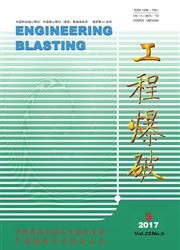

 中文摘要:
中文摘要:
岩石工程实践中,受动力荷载的作用现象比较普遍,例如工程爆破、自然地震及岩爆等。为了工程安全并兼顾经济效益的最大化,在这些工程问题的设计和施工中需要使用准确的岩石动态力学破坏强度及断裂韧度等力学性质。由于岩石动力测试较静态测试复杂得多,国际岩石力学学会岩石动力学专业委员会(ISRM—CRD)2012年才首次推出了岩石动态测试推荐方法,包括岩石动态压缩、动态拉伸及动态断裂方法。夏开文近几年在岩石动力实验室测量方面做了一系列工作,得到了国际同行广泛的认可,并执笔编写了ISRM动力测试推荐方法。夏开文作为新一届的国际岩石力学学会岩石动力学专业委员会(2011-2015)主席,负责继续推动把更多切实有效的岩石动力测试方法建议为国际岩石力学学会(ISRM)推荐方法。在此背景下,我们结合多年来的研究工作,总结一些准确可靠的岩石动力学测试方法,希望能被应用到我国的工程爆破实践中,以期进一步提高我国工程爆破施工的高效性和安全性。
 英文摘要:
英文摘要:
It is common for rocks subjected to dynamic loadings in various rock engineering practices, such as blasting, earthquakes and rock bursts. In order to ensure safety and to maximize benefit in these applications, it is crucial to use accurate dynamic strength and fracture properties of rocks during both de- sign and operation stages. Due to complexities in experimental design, instrumentation and data interpreta- tion, it is not until 2012 that the International Society for Rock Mechanics-Commission on Rock Dynamics (ISRM-CRD) proposed the first ever three dynamic testing methods, including dynamic compression, dy- namic Brazil test, and dynamic notched semi-circular bend test. Kaiwen Xia has conducted a series of dy- namic rock tests, which has been recognized by the international community of rock mechanics. He thus was in charge of writing these new ISRM suggested methods for rock dynamic tests. As the president of the new ISRM-CRD, Kaiwen Xia is responsible for proposing more ISRM suggested methods for rock dy- namic tests. In this review, several accurate and reliable rock dynamic test methods were discussed. It is hoped that these methods will be used by blasting engineering in China and the measurement results will be widely used in blasting designs to improve the efficiency and safety of blasting in China.
 同期刊论文项目
同期刊论文项目
 同项目期刊论文
同项目期刊论文
 期刊信息
期刊信息
